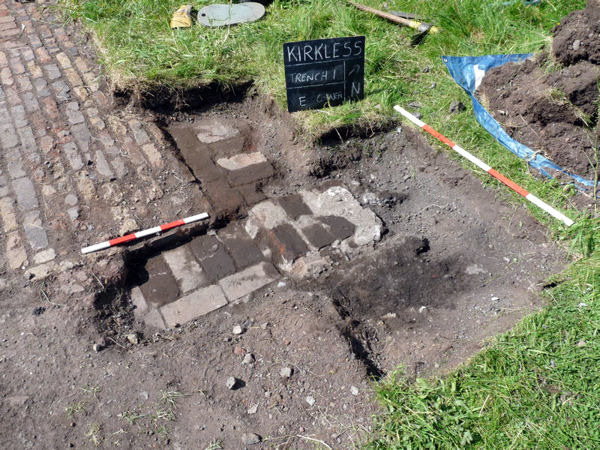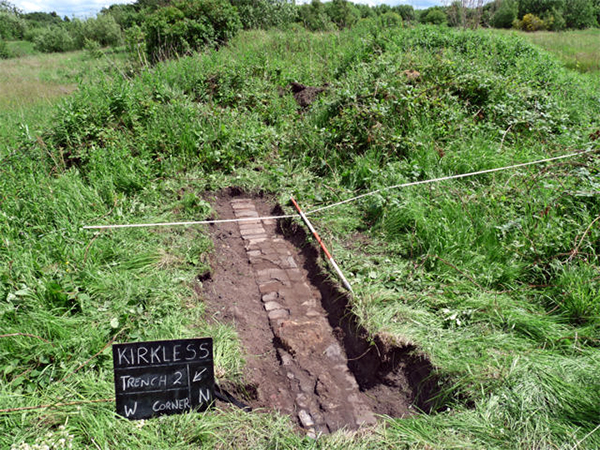
After two more visits to the Kirkless site we have now managed to establish the extent of the brick pavement feature. Last month's excavations revealed that the feature was enclosed on three sides by brick walls. This month we extended our trench on the fourth side to see how far the walling went in that direction. It turned out to be not very far and there does not appear to be any interconnecting wall, suggesting that the building was open on this side. We've also established that the corners on the opposite side had small detached brick plinths. This seems to suggest support bases for some sort of structural feature on the northeast side of the building.
The next thing to establish is how much of the Steel Works has survived on the northeast side of the site. It was becoming clear, speaking to local residents, that major landscaping in the 1980's resulted in huge swaths of the site being bulldozed away. There is now a depression (and even a fish pond) on the northeast side where we expected the factory to be. To find the extent of the destruction, we started a trench on the edge of what appeared to be the hard surface of the factory floor. This confirmed the raggedy edge of the destroyed area lying about 8.5 metres to the northeast of the pavement. All along this edge it appears that debris has been deliberately dumped to form a bank, (maybe to protect the edge from people fall off it). Towards the north side the bank eventually disappears as the depression gets shallower. It was here that we decided to put in our next trench to see if we could find the site's northwest extent.
 Luckily our first spade cut hit on another brick wall which we were able to chased in both directions. It seemed to be running parallel with the northeast wall of our pavement, (offset 14 metres to the northeast). We couldn't find the extent of it because of the debris bank on the south side and a path on the north. However, as it lies more than 28 metres to the northwest of the pavement, the suggestion is, the site is much bigger than we had originally anticipated.
Luckily our first spade cut hit on another brick wall which we were able to chased in both directions. It seemed to be running parallel with the northeast wall of our pavement, (offset 14 metres to the northeast). We couldn't find the extent of it because of the debris bank on the south side and a path on the north. However, as it lies more than 28 metres to the northwest of the pavement, the suggestion is, the site is much bigger than we had originally anticipated.
Summer trip
This year we will be visiting the Poulton Research Project in Cheshire. This multiperiod site has been running for twenty years and started as a joint project between Chester Archaeology and Liverpool University. It is now run independently as a volunteer and training site, relaying on donations from various sources but has close links with the West Cheshire College. It started with a study of a medieval chapel connected a Cistercian Abbey which disappeared in the 13th century. They then began to find evidence of Roman activity including high quality red-slip pottery, brooches, and coins. Earlier periods, including Mesolithic, also began to turn up with an assemblage of worked stone tools and struck flint being found. In recent years a large complex of Iron Age roundhouses has been discovered raging in date from the 5th to 1st century BC. Excavations on the site continue and this year will run until the end of August. We have been given the opportunity to have a guided tour of the current work on Saturday 15th August (which will include a reconstruction of an Iron Age roundhouse). We will also be visiting other sites on the day, which have yet to be arranged but the 18th century Ironworks at Bersham has been suggested. Please let me know asap if you would like to be included.
Ribchester
Excavations are also taking place at Ribchester this summer with dates available for volunteers in both July and August. There will also be a Roman re-enactment weekend on 11th and 12th July. If you are interested in this or want to get involved with the excavations, contact me or Darren Bentham or myself at our next meeting.
Next Meeting
Wednesday 1st July - in the Standish Suite at the Brocket Arms (7.30pm as usual). At short notice, our long term friend, Ian Miller from Oxford Archaeology North has agreed to give us a talk on the Cutacre site near Little Hulton. Excavations there, in advance of major development and land reclamation, have revealed both Prehistoric and Medieval activity (including Iron Age round houses). No doubt Ian will be his usual entertaining self. Hope to see you there, BA |



